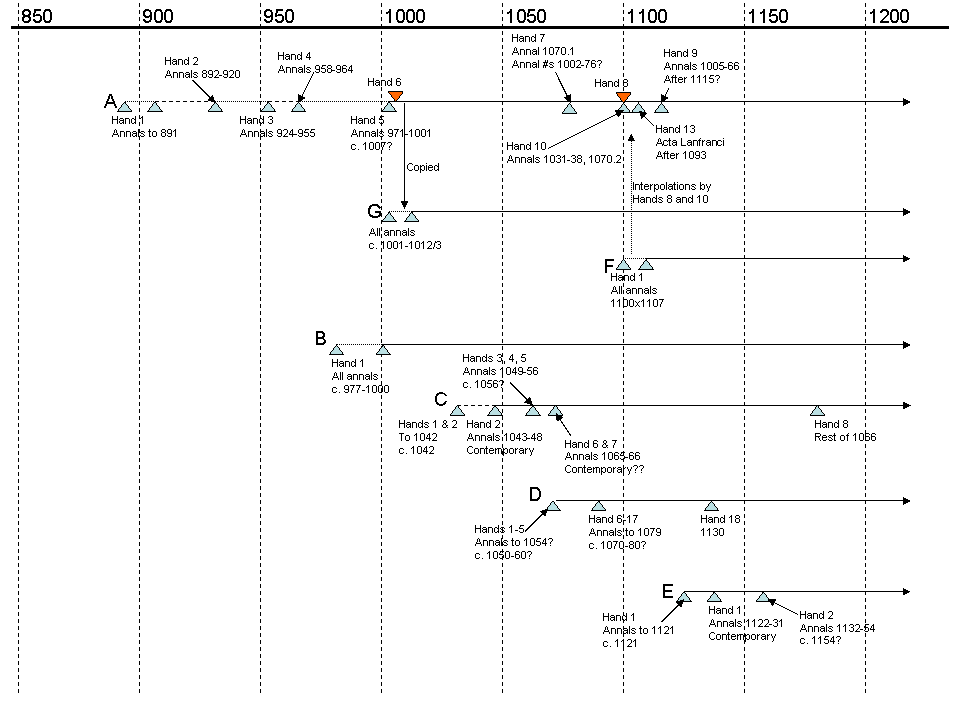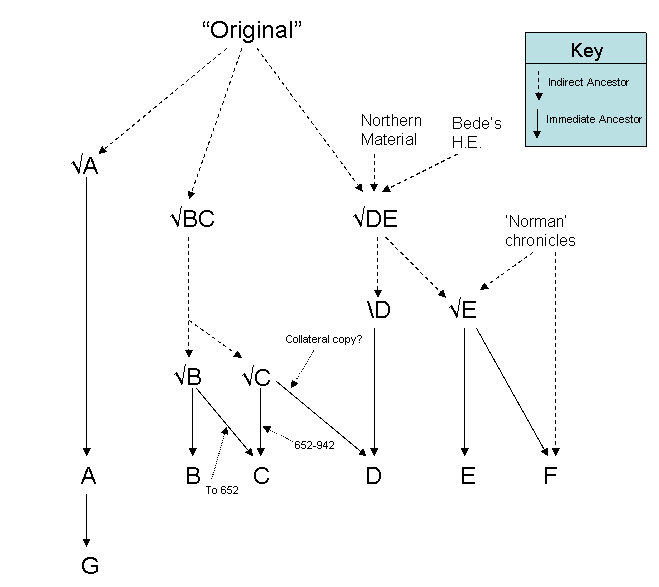The Anglo-Saxon Chronicle
An introduction to Chronicle, describing the origins of the Chronicle tradition,
the surviving manuscripts, their history and transmission.
The Manuscripts
The Anglo-Saxon Chronicle is a complex set of interrelated manuscripts, of which
the earliest is known as the Parker Chronicle.
There are seven major manuscripts comprising what is generally termed The Anglo-Saxon
Chronicle:
- Manuscript A (Corpus Christi College, Cambridge MS 173 ff. 1-32)
-
This, the oldest surviving manuscript, is sometimes known as the Parker Chronicle,
after Matthew Parker, the Archbishop of Canterbury who once owned it. Little is known
of its early history, only that parts of it were copied into Manuscript G some time
between 1001 and 1012/13 and that by the late eleventh century it was at Christ Church,
Canterbury, where the compiler of Manuscript F used it and it received a number of
entries by the F-scribe and other Canterbury hands, extending to 1070 in Old English
and to 1093 in Latin. The contents of some annals unique
to "A" show strong Winchester connections, as do some of the hands that contributed
to the text. However, the theory that the earliest section was copied at Winchester
is still disputed.
-
Online images: Folio 10r,
Folio 10v, lines 1-19
- Manuscript B (London, British Library, Cotton Tiberius A.vi)
-
This manuscript was copied by a single scribe in the late tenth century and contains
annals in Old English to 977. The manuscript has traditionally been attributed to
Abingdon but this is disputed. The manuscript must have been at Christ Church, Canterbury by
ca. 1100, when a list of popes was added, by the same scribe, to Manuscripts A and B.
- Manuscript C (London, British Library, Cotton Tiberius B.i)
-
This manuscript contains annals in Old English to 1066, where it breaks off in the middle
of the account of Stamford Bridge. A supply sheet, written in a twelfth century hand
concludes this account. It is written in seven or eight hands of the mid eleventh century
and slight changes in the hands suggest it may have been updated annually ca. 1043-48.
The text to 977 is so close to that of Manuscript B and that it has been proposed that B
and C shared a common exemplar.
-
Online images: Folio 128r
- Manuscript D (London, British Library, Cotton Tiberius B.iv)
-
This manuscript contains annals in Old English to 1079, where it breaks off in mid-sentence at
the bottom of a half-sized folio. No more than half a page of text can have been lost as a new
annal (for 1130) starts at the top of the other side. It is written in ten to eighteen hands
typical of the late eleventh or early twelfth centuries. The section of the manuscript covering
262 to 692/3 has been lost. The manuscript is a conflation of a northern development of the original chronicle,
known as the "Northern Recension" (which had been expanded with material from Bede's Historia Ecclesiastica
and other northern sources) and a manuscript similar to C.
- Manuscript E (Oxford, Bodlean Library, MS Laud 636)
-
This manuscript was most likely copied in 1121 at Peterborough (possibly to make good losses
after the disastrous fire of 1116) and maintained up to 1154. Like "D", this manuscript forms part
of the "Northern Recension" of the Chronicle, but also includes a set of 'Norman' chronicles in Latin and
unique material relating to Peterborough.
This is also known as the Laud Chronicle, after Archbishop Laud, its last private owner who acquired it in 1638
and as the Peterborough Chronicle.
-
Online images: Folio 1r
- Manuscript F (London, British Library, Cotton Domitian A.viii)
-
This bilingual chronicle with entries in Old English and Latin was written at Christ Church, Canterbury just after 1100.
It was compiled from various sources, including Manuscript A, the immediate ancestor of Manuscript E (√E),
the Annales Wintonienses, and a set of 'Norman' chronicles.
-
Online images: Folio 48r
- Manuscript G (London, British Library, Cotton Otho B.xi)
-
An early 11th century copy of Manuscript A. This manuscript was almost completely destroyed in a fire in 1731.
It is believed that the history of these documents is roughly as follows.
Sometime in the 9th century a chronicle was drawn up in Wessex. Some of the sources
used to compile this chronicle have been identified: Bede's Historia Ecclesiastica,
and its chronological summary; A continuation of this summary down to Ecgbryht (Egbert);
Northumbrian and Mercian genealogical lists; etc.
Other (non-extant) sources have been suggested for other material in the chronicles,
for example an earlier set of West Saxon annals down to 754 have been postulated
to account for the relative frequency of West Saxon references to this point. There
are very few (5) entries between 755 and 823 that refer specifically to Wessex,
and these are thought to come from an oral tradition. After 823 the material is
contemporary with the compilation. The date when this original (non-extant) chronicle
was compiled is uncertain, but it is thought that there was a chronicle up to 855,
as the genealogy for Æthelwulf in 855 look like a termination.
Copies of this chronicle were then copied to become the various extant manuscripts
roughly as follows.
-
The first part of the Parker Chronicle (Manuscript A) was probably written some time after 891 (where the first
hand finishes) and was continued to 1093. Manuscript G (almost completely destroyed
by fire in 1731) is an early 11th century transcript of Manuscript A probably made at Winchester.
Interestingly, all the evidence for the growth and alteration of Manuscript A has been ironed
out in Manuscript G so if only this had survived we would have little idea of the underlying
complexity of the transmission of these chronicles.
-
A lost chronicle similar to MS A, sent possibly to Abingdon, was copied to form:
- MS B; copied in the late tenth century (977x1000) and not continued
- MS C; copied around 1042, possibly updated annually to 1048, and continued to 1066.
-
A copy of the original chronicle was sent to the North where it was expanded with
material from Bede and other northern sources and continued with northern material.
MS D is a mid-11th century copy of this which was then continued to 1079.
-
A chronicle similar to the northern ancestor to MS D was compiled and sent to Canterbury
where it was kept until after 1066. MS E (the Laud manuscript) was copied from this
in 1121 and continued to 1154. MS F is another bilingual (Latin and Old English)
copy of this Canterbury chronicle.
The transmission of these manuscripts will be discussed in more detail below.
The Transmission of the Chronicle
Comparison of annals
TBA.
 TBA.
TBA.

Post-Conquest History of the Manuscripts
TBA.
Related Manuscripts
There are a number of manuscripts, which though they are not part of the core of
the Chronicle, must be examined for a full understanding of the Chronicle.
- Manuscript H (London, British Library, Cotton Domitian A.ix)
-
A fragment of a Chronicle dealing with 1113-1114, but independent from the account in Manuscript E.
- Manuscript I (London, British Library, Cotton Caligula A.xv)
-
An Easter Table Chronicle.
- Asser's Life of Ælfred
-
This is in part derived from a text of the Chronicle similar to MS A which
terminates in 887--at least this is when Asser last utilises it in his "Life".
- The Annals of St Neots
-
This is in part derived from a text of the Chronicle which extends to at
least 912.
- The Chronicon of Æthelweard
-
This is also derived from a text of the Chronicle similar to MS A.
Copyright © 1996-2006, Tony Jebson <tony@jebbo.co.uk>,
all rights reserved. Last modified 5th December 2006.
 TBA.
TBA.
 TBA.
TBA.